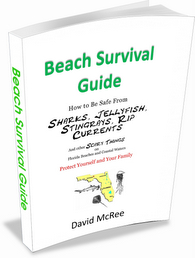
I took this photo from atop the dunes at Guana River State Park on Florida's Atlantic Coast. The low tide is exposing the break in the sandbar, revealing the location of a potential rip current. Click the photo to enlarge.
With Hurricane Earl raging off Florida’s Atlantic Coast, this Labor Day weekend has the potential of having a sad ending for anyone attempting to swim in the powerful hurricane surf. Heavy surf generates powerful rip currents. Your favorite swimming beach may become unsafe in high surf.
The annotations I made on the photo above show the location of a potential rip current. Notice the break in the sand bar. Large surf brings a heavy volume of water onto the beach. The water runs along the beach looking for a way to get back to the ocean. When it finds a break in the sandbar it rushes out, creating a powerful river of water moving seaward. The surf is very small in the photo above, so there is no rip occurring at the moment I snapped the photo, but the geography gives it away.
During heavy surf, rip currents can often be discovered by looking for darker water that appears churned up or perhaps choppy. There is often less surf breaking in the rip current. Always observe the water before you go in, and pay attention to any cautionary signs and flags that might warn of possible rip currents.

Signs are often posted at public beaches warning of the possible presence of rip currents. Jetty Park, Cape Canaveral, Florida.
If you are caught in a rip current, DO NOT FIGHT IT! People die in rip currents because they panic, they struggle, they exhaust themselves to the point that they can no longer keep their head above water. This is unnecessary. If you can float or tread water, a rip current need not be fatal.
If you are caught in a rip current there are two approaches you can use:
- Let the current carry you. Once you are out past the breaking waves the current will subside. Then you can swim parallel to the beach until you are away from the current. Get back into the breaking waves and let them carry you to shore. If you are too tired to swim, wave your arm and signal or call for help.
- Swim parallel to the beach until you are out of the grip of the rip current. Then let the waves carry you back toward the beach.
Link to video of Clearwater Beach Lifeguard Donovan Burns talking about rip currents.

These two swimmers have ventured out into some very powerful surf generated by Hurricane Ike on Anna Maria Beach.
Surf has a natural rhythm. An ebb and flow. Surfers are familiar with this and learn how to use the rhythm of the surf to their advantage.
Water pushes in toward the beach, then if flows rapidly back out. That outflow can easily knock you off of your feet and drag you out 30 feet very quickly. But it is not the same as a rip current. Inexperienced swimmers often panic when pulled off their feet, thinking they have been caught up in a rip current. But usually they can just wait a few moments and catch the next wave back to the beach.
One last note: you may often hear the term “rip tide.” What we are discussing here has nothing to do with the tides. The proper terminology is “rip current.”
Be safe, enjoy the beach, and have a great Labor Day weekend. And while in many parts of the country Labor Day signals the last beach weekend of the summer, in Florida it is just the beginning of a beautiful “fall” season at the beach. In case you don’t know what the fall season brings to Florida beaches, here’s a clue:
- Calmer waters
- Cooler daytime temperatures (80’s instead of 90’s)
- The end of the daily rains, thunder and lightning
- Fewer people overall
- Exquisite sunsets
See you at the beach!



